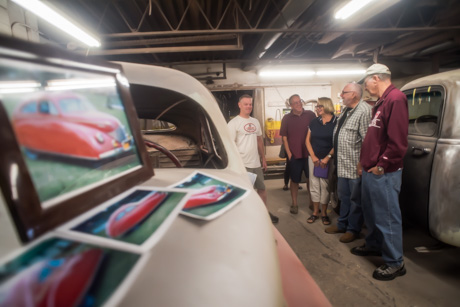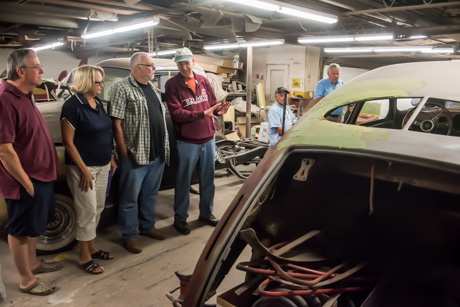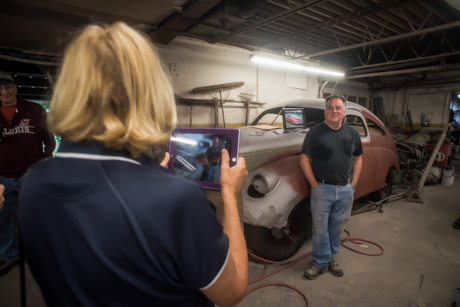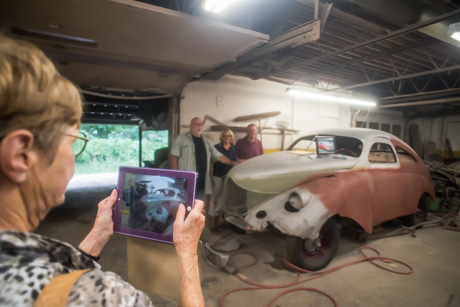
The Thomas Rocket Car is a family heirloom that is close to becoming a City of Batavia treasure, and the three children of the man who designed and conceived of the once-futuristic automobile think that's just how things should be.
“It’s great (that it’s coming back to Batavia)," said Gary Thomas, oldest son of the late Charles D. Thomas, "This is a Batavia car. It was conceived in Batavia. It was built in Batavia. It was driven around the town in Batavia for the first few years of its life."
Gary, now a resident of California, and sister Karen, of Hamburg, and brother Jeff, of Lockport, stopped Old World Body Shop, where owner Dick McClurg and a group of volunteers are in the midst of restoring the Rocket Car back to its 1938-era glory.
Charles Thomas designed the car and built it with the help of Norman Richardson, also a Batavia resident, in a shop at the corner of Main and Oak. Thomas dreamed of a car that would revolutionize the auto industry, with advanced safety features and a sleek design, but both General Motors and Chrysler passed on the design and war disrupted the auto industry, so the Thomas Rocket Car became another family sedan.
Thomas and Richardson completed the car in 1938 and Thomas didn't meet his wife until 1939 and Gary, the oldest, wasn't born until 1942, so the car was a well-established part of the children's lives in their early years, at least until mom put her foot down and told dad to get rid of it.
Karen told the story.
Their mother took the children to the grocery store in the car one day and when she needed to drive over railroad tracks, the car stalled.
Gary said he thinks the car stalled because the tracks were a bit higher than the road, causing the car to have to climb a 45-degree angle and his mother wasn't going quite fast enough, so the fuel drained from the carburetor and the Rocket Car sputtered and stopped.
Mom yelled at the children to get out of the car fast. She feared a southbound train was coming.
A man came along and asked if she knew how to start the car if he pushed it. She did, so he pushed it off the tracks, the car rolled down the hill about 100 yards and mom popped the clutch and it started right up.
"After that," Karen recalled, "my mother said, 'that's it, get rid of the car. I'm not going to endanger my children. Get rid of the car,' and my father did get rid of the car after that, otherwise, we probably would have kept it."
There are a lot of family stories around the car, the siblings said.
"We rehearsed them all last night over chicken wings," Gary joked.
Like the time the family had to stop at Mercy Hospital, Karen said, and somehow the car got out of park (maybe the kids were messing with something they shouldn't have been messing with, she said) and somebody bumped the car and it started to roll toward the street.
"A nun hopped into the car and stopped it so it didn't go crashing into anything," Karen said, "but it went into the middle of the street and she just left it there."
Many of the memories involve other people's memories of the unique car.
"Dick Moore's favorite story (Moore is one of the people who helped get the ball rolling to save the car and donate it to the City) is the time he first saw the car on Main Street," Gary said. "My father had taken off the passenger rear wheel, so it was only on three wheels and my father was testing the stability of the car and drove it down Main Street and down and around and back and it never tipped it over so he pronounced it stable. But Dick Moore saw this car going by with three wheels on it and was immediately taken by it."
Jeff remembers the time he was meeting with an architect in Buffalo and the man found out about Jeff's roots in Batavia and asked, "Your dad isn't Charlie Thomas, is he?"
The man then recalled the Thomas Rocket Car.
"He said, 'I remember driving around in the Thomas Rocket Car,' " Jeff said. " 'I was in my 20s and we’d drive around Batavia, and we’d have our arms out the side of the car and people would look at us they would beep and stuff like that.'
"There’s a lot of people around who rode in it or remember it," Jeff added.
There's still a lot of restoration work to do on the car. By Thanksgiving, McClurg hopes to have the passenger side primed and then he can flip the car on its side and start working on the undercarriage. After that, more body work, painting, and interior restoration.




While reading the part of
While reading the part of this article that told about the Thomas' car stalling at the RR track crossing, it reminded me of something my father told me.
I'm gonna say it was back in the mid-80's, or so, when my parents were somewhere around 70-years-old. We were sitting around the dining room table, talking about the "old days" (way before I was born).
Somehow the conversation evolved into talking about the cars of "yesteryear". My dad told of a time when it was a common sight ("back in the day") to see (northbound) vehicles stopping at the bottom of Burleigh Hill, in Pavilion (NY), to turn around (because the only way to climb the hill was in reverse gear).
Well, I had never heard of such a thing, so I asked him why. He explained that a lot of vehicles (back then) only had gravity-fed fuel systems. And, because they had no fuel "pumps", the amount of fuel in the gas lines wasn't enough to get the vehicle to the top of the hill. Therefore, they'd "back" up the hill, allowing gas to flow (using gravity) from the tank to the engine.
So, I would imagine that Mr. Thomas' assumption of why his father's car stalled was probably correct. Personally, I would've thought that, by 1939, fuel pumps would've been in common use, but, I really don't know.
As an aside, I have a friend in Rochester who owns two (1926 - I believe) Ford Model T's. When he takes them to be inspected, he sais he's actually had the person doing the inspection ask him where the "parking brake" is.
He always tells them that it's on the floorboard, behind the driver's seat. He said it's only a matter of minutes before the inspector comes back and says the only thing behind the seat is a brick. That's when he explains that there is no "parking brake" on that vintage car. When he parks on an incline, he puts the brick under the wheel, to keep it from rolling. I laugh to myself every time I think about that story.